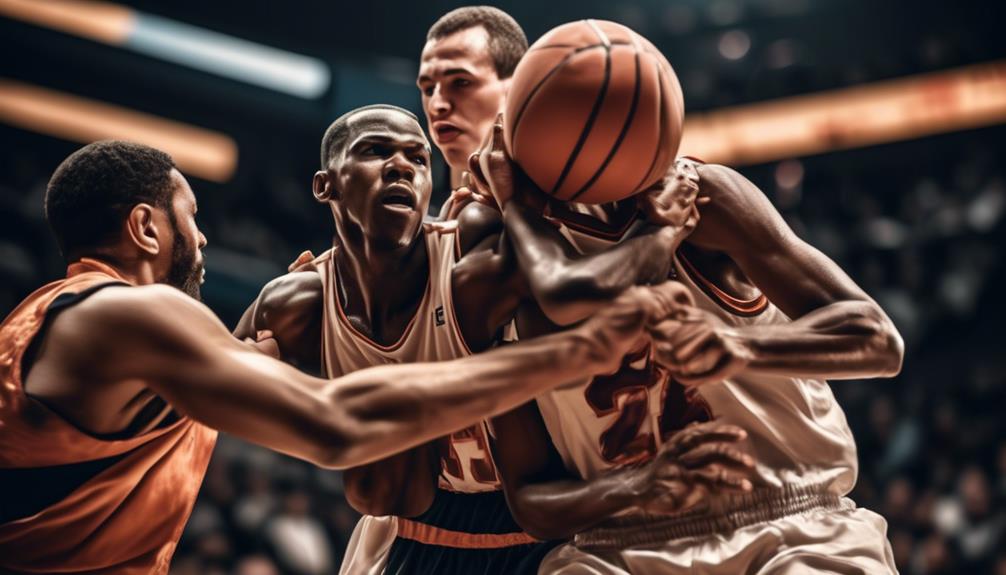Top Defensive Strategies for Winning Basketball Teams
So, you think defense wins championships? Well, you're onto something there.
When it comes to basketball, having a solid defensive strategy can be the key to securing victories on the court. But it's not just about swatting shots and stealing the ball. There's a whole world of defensive tactics and techniques that can elevate your team's game to the next level.
Whether you're looking to lock down the paint or shut down the perimeter, understanding and implementing top defensive strategies is crucial for any winning basketball team.
Full-Court Press Defense
Implementing a full-court press defense can disrupt the opponent's offense and create scoring opportunities for your team. By applying relentless defensive pressure from one end of the court to the other, you can force turnovers, create chaos, and limit the opposing team's ability to run their offensive sets effectively. When employing this strategy, it's crucial to have a solid understanding of press break strategies. By studying your opponent's tendencies and weaknesses, you can anticipate their movements and apply trapping techniques strategically. This allows you to cut off passing lanes, double-team ball handlers, and force rushed decisions, leading to turnovers and fast break opportunities for your team.
To execute a successful full-court press, it's essential to communicate effectively with your teammates and maintain disciplined positioning. As the defensive pressure intensifies, players must work together to anticipate the opponent's movements and disrupt their offensive flow. This coordinated effort can lead to steals, deflections, and shot clock violations, giving your team a significant advantage.
In addition to creating scoring opportunities, a well-executed full-court press can also wear down the opposing team both mentally and physically. By forcing them to constantly battle against defensive pressure, you can disrupt their rhythm and tire them out, impacting their performance in the later stages of the game.
Zone Defense Tactics
To build upon the disruptive defensive pressure of a full-court press, zone defense tactics provide an effective method for controlling the flow of the game and limiting the opposing team's scoring opportunities. When employing zone defense tactics, it's crucial to focus on defensive zone positioning and zone defense rotations to effectively disrupt the opposing team's offensive plays.
Zone Defense Tactics
- Defensive Zone Positioning: Establishing proper defensive zone positioning is key to effectively executing zone defense tactics. Players must maintain their positions within the designated zones to effectively guard against potential scoring opportunities. This requires a keen understanding of the team's defensive strategy and the ability to anticipate the movements of the opposing team.
- Zone Defense Rotations: Effective zone defense rotations are essential for seamlessly adjusting to the movements of the opposing team. Players need to communicate and work together to ensure that the defensive zones are adequately covered at all times. Quick and precise rotations can significantly disrupt the opposing team's offensive rhythm and force them into making unfavorable decisions.
Man-to-Man Defensive Techniques
Frequently, basketball teams utilize man-to-man defensive techniques to closely guard individual opponents and disrupt their offensive plays. When employing man-to-man defense, on ball pressure techniques are crucial. This involves applying intense pressure on the player with possession of the ball, making it difficult for them to dribble, pass, or shoot. It's vital to stay low, move laterally, and use quick hands to challenge the offensive player effectively.
In addition to on ball pressure, off ball positioning is equally important in man-to-man defense. Effective off ball positioning entails being in the passing lanes, denying easy passes to the player being defended, and being ready to help teammates if they get beat off the dribble. By denying passing lanes, you can force turnovers and disrupt the opposing team's offensive rhythm.
Another key aspect of man-to-man defense is switching assignments when necessary. This means seamlessly changing defensive responsibilities with teammates to ensure that every offensive threat is closely guarded. It requires clear communication and an understanding of each player's strengths and weaknesses on defense.
Defensive Transition Principles
After effectively applying man-to-man defensive techniques, the next critical aspect to focus on is how to maintain defensive integrity during the change from offense to defense. Defensive transition principles are vital for preventing easy scoring opportunities for the opposing team.
To excel in this area, you need to focus on:
- Quick Communication: Players need to effectively communicate with each other to identify assignments and prevent any offensive player from getting behind the defense.
- Immediate Sprint Back: As soon as the possession changes, players must sprint back to protect the basket, denying the opponent any advantage in numbers.
- Protecting the Paint: It's crucial to prioritize protecting the paint, ensuring that no easy layups or dunks are conceded during transition.
- Matchup Awareness: Players must be aware of their matchups and be able to quickly locate their assigned player to minimize scoring opportunities.
Transition execution is key to a successful defensive strategy. It involves seamlessly transitioning from offense to defense, ensuring that the opposing team doesn't capitalize on any gaps or defensive lapses. Defensive positioning is equally important, as players need to be in the right place at the right time to impede the opposing team's progress and scoring chances.
Help-Side Defense Strategies
When implementing help-side defense strategies, it's essential to emphasize the importance of positioning and anticipation in order to effectively support your teammates and disrupt the opposing team's offensive plays.
Rotating help is a critical aspect of help-side defense, and it involves quickly moving to provide assistance to a teammate who's guarding the player with the ball. Proper positioning is key to executing rotating help effectively. As a defender, you should strive to be in a position that allows you to quickly step in and provide support to your teammate without leaving an opposing player open for a shot or a pass.
To achieve optimal positioning, focus on maintaining a stance that allows you to see both your assigned player and the player with the ball. This will enable you to anticipate when and where you need to rotate to provide help. Additionally, staying a step ahead of the offense by anticipating their movements and potential passing lanes will allow you to disrupt their plays more effectively.
Another important aspect of help-side defense is communication. Clear and constant communication with your teammates about positioning and potential threats can help ensure that everyone is on the same page and ready to provide the necessary support.
Defensive Communication Guidelines
To enhance defensive coordination and effectiveness, prioritize clear and concise communication among teammates to ensure everyone is informed and ready to support each other during gameplay. Effective communication on the defensive end is crucial for a winning basketball team.
Here are some guidelines to improve your team's defensive communication:
- Clear and Precise Instructions: Encourage players to use short, specific phrases to communicate defensive rotations and positioning. Phrases like 'I got ball,' 'Help left,' or 'Screen coming' can quickly convey important information to teammates.
- Active Listening: Emphasize the importance of active listening on defense. Players shouldn't only communicate their own positioning and rotations but also listen to their teammates' instructions and adjust accordingly.
- Consistent Verbal and Non-Verbal Cues: Establish consistent verbal and non-verbal cues for defensive switches, traps, and rotations. This helps in avoiding confusion and ensures that everyone is on the same page.
- Encouraging Supportive Environment: Foster an environment where players feel comfortable speaking up and offering constructive feedback. This helps in building trust and cohesion within the team, leading to improved defensive communication.
Defensive Rebounding Fundamentals

Improving your team's defensive rebounding starts with maintaining the same clear and concise communication strategies outlined for defensive coordination. In addition to communication, mastering fundamental box-out techniques and rebounding positioning is crucial. Box out techniques involve creating space between you and the opponent, allowing you to secure the rebound. Proper positioning ensures that you're in the best spot to grab the ball once it bounces off the rim.
To enhance your team's defensive rebounding, incorporate specific drills into practice sessions. Defensive rebounding drills help players develop the skills needed to secure the ball effectively. These drills can focus on techniques such as blocking out opponents, reading the trajectory of the ball, and timing jumps to grab the rebound at its highest point. By consistently practicing these fundamentals, your team can significantly improve its defensive rebounding performance.
Incorporating rebounding fundamentals into your team's defensive strategy can lead to a competitive edge. Emphasizing the importance of boxing out, positioning, and practicing specific defensive rebounding drills will contribute to a more cohesive and successful defensive unit. Remember, defensive rebounding isn't just about individual efforts; it requires collective awareness and synchronized movements to secure the ball.
Defending Pick-and-Roll Situations
In defending pick-and-roll situations, your team must prioritize quick communication and coordinated movement to disrupt the offensive play. This defensive strategy requires seamless teamwork and individual discipline to counter the offensive tactic effectively.
To effectively defend pick-and-roll situations, consider the following strategies:
- Switching assignments: When executed correctly, switching assignments can effectively neutralize the pick-and-roll play by denying the offensive players any advantage gained from the screen. It requires players to communicate and be aware of their defensive assignments to seamlessly switch and cover the offensive threats.
- Hedge and recover techniques: Employing hedge and recover techniques involves the defending player guarding the screener to temporarily disrupt the ball handler's progress while the original defender fights through the screen to recover and defend. This technique requires precise timing and coordination to prevent the offensive team from exploiting the defensive coverage.
- Anticipate and communicate: Defending pick-and-roll situations necessitates players to anticipate the offensive play, communicate effectively, and adjust positioning accordingly. Anticipating the movements of the offensive players and communicating effectively can help disrupt the pick-and-roll and force turnovers.
- Maintain defensive positioning: It's crucial for defenders to maintain proper positioning when defending pick-and-roll situations. This involves staying balanced, keeping the offensive players in front, and being prepared to react to any changes in the offensive play.
Frequently Asked Questions
How Can Teams Effectively Defend Against a Fast Break Offense?
To defend against a fast break offense, you need to focus on transition defense and defensive rotations. Then, work on defending pick and roll by maintaining proper defensive positioning to disrupt the offense's flow.
What Are Some Common Mistakes Teams Make When Implementing a Full-Court Press Defense?
When implementing a full-court press defense, common mistakes include overcommitting, leaving open lanes, and failing to rotate effectively. To counter these, focus on communication, maintaining proper positioning, and being prepared for fast break defense.
How Do Teams Adjust Their Zone Defense Tactics Against a Team With Strong Outside Shooters?
When defending the perimeter against a team with strong outside shooters, you need to adjust your zone defense tactics by switching strategies. This involves staying close to shooters and communicating effectively to prevent open shots.
What Are Some Advanced Man-To-Man Defensive Techniques That Teams Can Use to Shut Down Opposing Star Players?
To shut down opposing star players, focus on defensive footwork and player positioning. Use pick and roll and switching strategies to disrupt their rhythm. By staying agile and anticipating their moves, you can effectively neutralize their impact on the game.
How Can Teams Improve Their Defensive Communication to Better Anticipate and React to Offensive Plays?
Improve communication to anticipate and react to offensive plays by utilizing clear signals and constant talking. Strengthen team defensive strategies to better coordinate movement and cover potential scoring threats. React swiftly and decisively to shut down opponents.
Conclusion
So, if you want your basketball team to dominate on the defensive end, make sure to implement these top strategies.
Utilize the full-court press to apply pressure, employ zone and man-to-man tactics, focus on defensive transitions, communicate effectively, and master defensive rebounding and pick-and-roll defense.
By incorporating these strategies into your game plan, you'll be well on your way to shutting down the opposition and securing more wins on the court.
